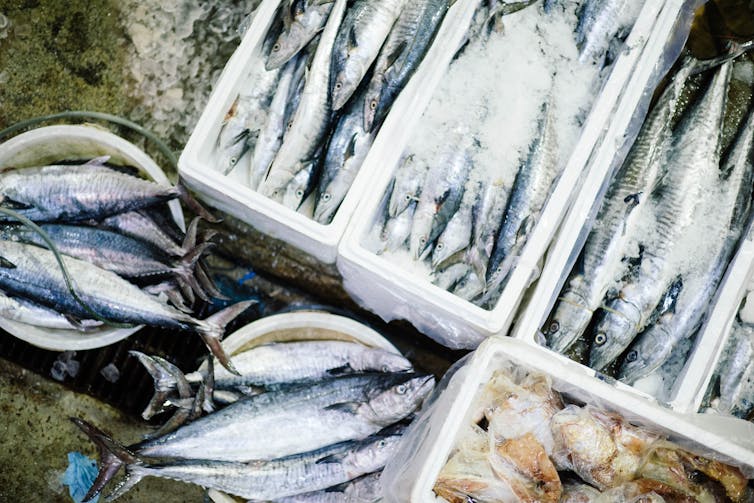You wouldn’t expect fish and melanoma to be in the same headline – but they were last week. Researchers in the United States reported a higher risk of developing melanoma, a common type of potentially deadly skin cancer, in people who ate a relatively large amount of fish.
The researchers speculated their results may be due to levels of contaminants in some fish species – especially fatty fish. These contaminants include polychlorinated biphenyls (PCBs) – synthetic chemical pollutants used as equipment coolants and lubricants and as paint additives. PCBs are commonly found in the environment and can cause cancer in humans.
But a detailed look at the research shows the findings don’t necessarily mean we should all be cutting fish from our diets for fear of skin cancer.
Beyond the headline
The headline comes from a published study that followed more than 490,000 adults in the US for more than 15 years and checked cancer registry databases to see how many melanomas occurred within that same group of adults. Researchers classified melanomas as “in-situ” meaning on the skin surface, or “malignant” meaning they had spread deeper.
They also asked study participants about how much fish they usually ate using a reliable food-frequency questionnaire.
People in the study reported how often they ate fish and their portion sizes of fried fish or fish sticks, non-fried fish or seafood such as flounder, cod, shrimp, clams, crabs or lobster. They also reported how much and how often they ate canned tuna, including both water- and oil-packed tuna.
The average amount of fish those in the study ate varied from 20 grams or less per week (equivalent to the size of half a matchbox) up to about 300 grams a week.
Among the lowest fish eaters there were 510 cases of in-situ and 802 cases of malignant melanoma over the 15 years compared to 729 and 1102 respectively in the highest fish-eating group. This means the rates were 28% and 22% higher for both melanoma in-situ and malignant melanoma for those who ate the most fish compared to the least.
Looking at specific types of fish, there was a higher melanoma rate among people who ate more tuna and non-fried fish. Interestingly, there was no association with fried fish intake. While that appears counter-intuitive, it is likely due to the very small intakes of fried fish – ranging from less than one up to seven grams a day (equivalent to one heaped teaspoon).
Although the researchers adjusted their analyses for factors that could affect results – such as physical activity, smoking, family history of cancer and alcohol intake – the adjustment for daily UV exposure was only based on the average UV index for the suburb they lived in. This means there was no adjustment for UV exposure related to a person’s occupation. They also did not have information on the melanoma risk factors such mole count, hair colour, history of severe sunburn or individual sun-related behaviours.
Observation is not causation
This study does not prove eating fish causes melanoma. This is because it’s a “cohort study”, meaning people were observed over time to see whether they developed melanoma or not.
There was no intervention to feed them specific amounts of fish, which would not have been practical to do over 15 years anyway. Researchers did measure a range of behaviors at the beginning of the study (or “baseline”), such as dietary intake and physical activity levels. But these could have changed over time.
So the results are based on observation rather than cause and effect. This doesn’t mean observational results should be ignored, though.
Fish, especially fatty fish such as tuna, can contain contaminants such as mercury and PCBs. This could contribute to the findings that eating more fish is associated with a higher rate of both malignant melanoma and melanoma in-situ (skin cancer).
PCBs are readily absorbed into the body, accumulating in fat stores and staying there for years.

Unsplash/Tim Davies, CC BY
The fish link has been studied before
The role of contaminants that may be present in some fish needs to be considered further. A 2017 study of more than 20,000 Swedish women evaluated PCB exposure – potentially from fatty fish – and the incidence of melanoma.
After four and a half years of follow-up, researchers reported four times the risk of malignant melanoma for those women with the highest PCB exposure via their diet compared to the lowest.
However, this study also reported the intake of omega-3 fats found in fish and identified that among the women with highest intake there was an 80% lower risk if melanoma, even after they adjusted for levels of dietary PCB exposure. This could explain why a 2015 systematic review of case-control and cohort studies found higher fish intakes seemed to protect people from malignant melanoma of the skin in some, but not all, studies.
Regular monitoring of contaminants in fish sold here is conducted by Food Standards Australia New Zealand (FSANZ). It puts total contaminant exposure levels well below Australian and European permitted levels.
For lots of other health reasons, including lowering your risk of heart disease or death for all causes, we should keep eating Australian fatty fish such as salmon, tuna and sardines.

Unsplash/Chuttersnap, CC BY
Don’t take fish off the menu
Further studies in other groups are needed that evaluate PCBs and exposure to other contaminants including dioxins, arsenic and mercury, while also adjusting for individual factors such as sun exposure, skin type and history of sunburn. Such research could help strengthen or refute the newly reported US findings.
Given the positive benefits of eating fish including for heart health and nutritional value, my advice to Australians would be to eat fish caught in Australian or New Zealand waters – and to heed sun-safe advice to minimize your risk of melanoma.![]()
Clare Collins, Laureate Professor in Nutrition and Dietetics, University of Newcastle. This article is republished from The Conversation under a Creative Commons license. Read the original article.










